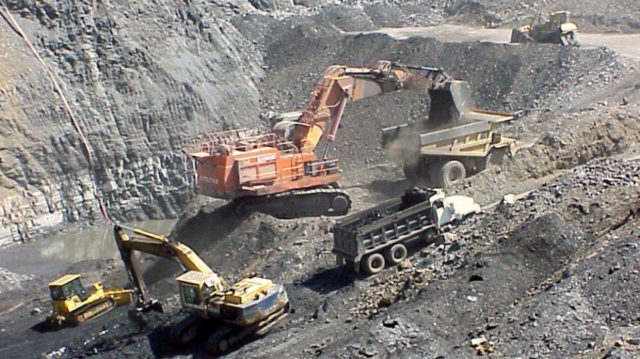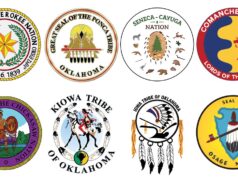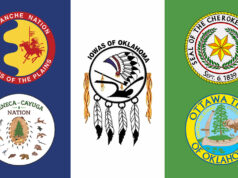

The U.S. Office of Surface Mining Reclamation and Enforcement added a notice to the Federal Registry on May 18 that prevents the state of Oklahoma from exercising regulatory jurisdiction under the Surface Mining Control and Reclamation Act of 1977 on lands of the Muscogee Nation, which recently had its reservation affirmed by the U.S. Supreme Court.
The notice means the Oklahoma Conservation Commission and Oklahoma Department of Mines now only have enforcement authority and authorization to conduct “routine” regulatory activities over active and abandoned coal mines within the Muscogee Nation. Previously, the state agencies also made and implemented rules regarding surface coal mining and reclamation.
This story is a part of the Oklahoma Media Center’s Promised Land effort, which shows how the landmark McGirt v. Oklahoma decision will affect both tribal and non-Indigenous residents in the state.
Owing to subsequent state-court decisions also affirming the Cherokee, Chickasaw, Choctaw and Seminole reservations, some attorneys believe the new federal order applies to the bulk of eastern Oklahoma.
“Because the Oklahoma Court of Criminal Appeals have already ruled that [the SCOTUS decision] also applies to the other four major tribes (…) this apparently means that Oklahoma has lost jurisdiction of all of the Surface Mining Act in eastern Oklahoma,” said Drew Kershen, a retired attorney and former professor at the University of Oklahoma College of Law. “That’s the way the federal government is interpreting it. This is a very significant loss of power by Oklahoma.”
A branch of the U.S. Department of the Interior, OSMRE sent letters April 2 to the Oklahoma Department of Mines and the Oklahoma Conservation Commission notifying the agencies of the jurisdiction change and to initiate the transfer of paperwork to OSMRE.
Representatives of both state agencies deferred comment to the Oklahoma Attorney General’s Office and Gov. Kevin Stitt.
‘This obviously opens up a situation for litigation’
The surface mining notice continues the legal aftermath of the July 2020 SCOTUS ruling in McGirt v Oklahoma, which affirmed the Muscogee Nation to be an Indian Country reservation as defined under 18 U.S.C. 1151a. While the case specifically deal with jurisdiction over major crimes that occur on tribal lands, the reservation designation has numerous implications over property rights and regulations.
On May 18, the day the OSMRE notice was added to the Federal Registry, U.S. Sen. James Lankford (R-Okla.) expressed concern that the development could cause further litigation in front of the Senate Committee on Energy and Natural Resources.
“The Office of Surface Mining made a decision to send out a letter to the state without any warning, without any advance, to be able to say, ‘We’ve just reinterpreted things, McGirt said criminal (matters), we now believe that this is also including (civil matters),’ although the (Supreme) Court didn’t speak to that,” Lankford said during Robert T. Anderson’s nomination hearing for solicitor of the U.S. Department of the Interior. “This obviously opens up a situation for litigation.”
‘Other ongoing cases that affect property’
In a statement provided to NonDoc on Monday, Gov. Kevin Stitt’s communications director critiqued the expansion of the McGirt ruling from criminal to civil jurisdiction.
“The McGirt ruling was strictly limited to criminal jurisdiction and the federal Major Crimes Act, yet some in the Biden administration continue to abuse McGirt to illegitimately justify gross federal overreach,” said Carly Atchison. “The state categorically rejects any attempt to undermine Oklahoma’s constitutional rights, and Gov. Stitt has communicated his concerns to President Biden.”
Oklahoma Solicitor General Mithun Mansinghani, who works in the Attorney General’s Office, sent NonDoc a statement detailing where the OSRME notice might lead lawyers next.
“Is this the first time McGirt is impacting property rights? No, although it is not clear that this impacts property rights in the sense that it does not impact property ownership,” Mansinghani said. “Here, the question is who can regulate certain activities involving surface coal mining — state regulators or federal regulators?”
Mansinghani referenced other civil questions pending about civil jurisdiction within the reservations.
“Other ongoing cases that affect property include challenges to ad valorem taxation, challenges to the Corporation Commission’s authority over oil and gas issues, and challenges to the applicability of state laws to oil and gas issues in state district court,” Mansinghani said. “We are still in conversation with the federal government about this issue. In the meantime, the Department of Mines and Conservation Commission are continuing to regulate for the health and safety of Oklahomans while cooperating with our federal partners as they always have.”
Oklahoma Secretary of Energy and Environment Ken Wagner said the agencies he oversees are disappointed with the notice.
“We believe that the Department of Interior is misinterpreting both the McGirt case and the statute authorizing primacy,” Wagner said.
He said the situation has been difficult, “given the fact that we don’t have an attorney general right now.”
Oklahoma Attorney General Mike Hunter resigned May 26.
OSMRE is the regulatory authority over surface mining and reclamation projects on Indian Country land where a tribe has not obtained primacy. At the time of this story’s publication, there is no claim for primacy on surface mining authority from any of the five tribal nations discussed here.
In March 2015, The Oklahoman published an articled about the state of the coal industry in Oklahoma:
Oklahoma has vast deposits of coal with an estimated 1.6 billion tons beneath 19 counties in northeastern and southeastern portions of the state. The coal industry employs 250 Oklahomans directly, according to statistics provided by the Oklahoma Department of Mines.
Most of the coal is bituminous coal beds, and some have a high sulfur content. Oklahoma has produced 294 million tons of coal since the first mine opened in 1873 in McAlester. Those numbers reflect production through 2010, the most recent figures available from the Department of Mines.





















